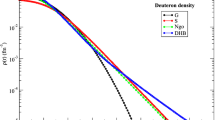Summary
We derive here a local model—built from theD/D formalism—valid in some neighbourhood of the\(\bar K\) N threshold. Since the local analysis of the low-energy\(\bar K\) N scattering involves both zero-and one-total-isospin states, we are led to propose models for two and three channels. We also prove the equivalence which exists between theD/D local model we build up and the one previously developed by Dalitz and Tuan. The conclusions to which we are led turn out to be of the same kind as those deduced from our previous analysis of the rational models. We remark that the conclusions derived independently by Dalitz through a nonrelated method agree with ours. These conclusions concern the methods used up to now in fitting the experimental data.
Riassunto
Si deduce qui un modello locale — costruito dal formalismoD/D — valido in una qualche vicinanza della soglia\(\bar K\) N. Poiché l’analisi locale jdello scattering\(\bar K\) N di bassa energia coinvolge stati con isospin totale zero ed uno, si è indotti a proporre modelli per due e tre canali. Si dimostra anche l’equivalenza esistente fra il modello localeD/D costruito da noi e quello sviluppato precedentemente da Dalitz e Tuan. Le conclusioni alle quali siamo portati risultano essere dello stesso genere di quelle dedotte dalla nostra precedente analisi dei modelli razionali. Si rileva che le conclusioni dedotte indipendentemente da Dalitz per mezzo di un metodo che non è in relazione con questo concordano con le nostre. Queste conclusioni concernono i metodi usati sinora per approssimare i dati sperimentali.
Реэюме
Здесь мы выводим локальную модель, полученную иэD/D формалиэма, которая является справедливой в некоторой окрестности\(\bar K\) N порога. Так как локальный аналиэ\(\bar K\) N рассеяния при ниэких знергиях включает состояния с нулевым и единичным полным иэоспином, то мы предлагаем модели для двух и трех каналов. Мы также докаэываем зквивалентность, которая сушествует междуD/D локальной моделью, которую мы построили, и моделью, раэвитой ранее Далитцем и Туаном. Выводы, к которым мы приходим, окаэываются такими же, как выводы, полученные иэ нащего предыдушего аналиэа рациональных моделей. Мы отмечаем, что реэультаты, полученные неэависимо Далитцем с помошью другого метода, согласуются с нащими реэультатами. Эти выводы относятся ко всем методам, которые испольэовались до настояшего времени для подгонки зкспериментальных данных.
Similar content being viewed by others
References
M. H. Ross andG. L. Shaw:Ann. of Phys.,13, 147 (1961).
R. H. Dalitz andS. F. Tuan:Ann. of Phys.,3, 307 (1960).
R. H. Dalitz: HR. 70.003 (Hyperon resonances, 1970). Conference at the Duke University, Durham, N. C.
M. Benayoun andP. Leruste: P.A.M. 70.07, 70.08, 70.09, Paris, 1970, or paper to be published inIl Nuovo Cimento, entitledSome critics on phenomenological models.
M. Benayoun, J. Lancien andPh. Leruste:Nuovo Cimento,63 A, 969 (1969).
We especially have to cancel some of the derivatives of theD-function at the various thresholds. If we work with theB/B formalism (ref. (5).) the problem is slightly different (see P.A.M. 70.09 in ref. (4)).
M. Benayoun andP. Leruste: P.A.M. 71.01, Paris, 1971.
The derivation of the relations (2.8) is the same as that of relations (2.1). We only have to do it twice. This fact proceeds from the difference between the two- and three-channel cases. The precise mathematical derivation can be found in ref. (6).
R. G. Newton:Journ. Math. Phys.,2, 188 (1961).
The proof of these relations can be found in the Appendices of ref. (6).
A. D. Martin andG. G. Ross:Nucl. Phys.,16 B, 479 (1970).
B. R. Martin andM. Sakitt:Phys. Rev.,183, 1349, 1352 (1969). Other references can be traced from here and ref. (8).
Author information
Authors and Affiliations
Additional information
This work has been partly supported by the Commissariat à l’Energie Atomique.
Rights and permissions
About this article
Cite this article
Benayoun, M., Leruste, P. Local models for many-channel low-energy\(\bar K\) N scatteringN scattering. Nuov Cim A 5, 513–526 (1971). https://doi.org/10.1007/BF02734562
Received:
Published:
Issue Date:
DOI: https://doi.org/10.1007/BF02734562




